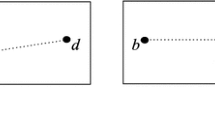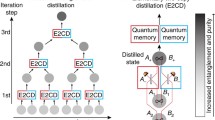Abstract
A key ingredient of quantum repeaters is entanglement distillation, i.e., the generation of high-fidelity entangled qubits from a larger set of pairs with lower fidelity. Here, we present entanglement distillation protocols based on qubit couplings that originate from exchange interaction. First, we make use of asymmetric bilateral two-qubit operations generated from anisotropic exchange interaction and show how to distill entanglement using two input pairs. We furthermore consider the case of three input pairs coupled through isotropic exchange. Here, we characterize a set of protocols which are optimizing the trade-off between the fidelity increase and the probability of a successful run.





Similar content being viewed by others
Notes
Here, we set \(\hbar = 1\), and time-ordering in Eq. (7) is not necessary since \([H_{ij} (t), H_{ij} (t')] = 0\) for all t and \(t'\).
We can separate the time evolution of the four-particle system in Eq. (10) into the two-particle propagators \(U_{13} (\alpha )\) and \(U_{24} (\beta )\) because the Hamiltonians describing each exchange interaction commute, i.e., \([H_{13}(t),H_{24}(t')]=0\) for all t and \(t'\), with \(H_{ij} (t)\) given in Eq. (6).
The square of \(\sqrt{{\textsc {swap}}}^{-1}\) is also the swap operation and it can be understood as another root of swap.
For clarity of notation: the unitaries \(U_A\) and \(U_B\) are assumed to be represented as matrices on \(({\mathbb {C}}^2)^{\otimes 6}\) with \(U_A\) acting as identity on Bob’s qubits and \(U_B\) as identity on Alice’s.
References
H.J. Kimble, Nature 453, 1023 (2008)
A.K. Ekert, Phys. Rev. Lett. 67, 661 (1991)
H.-J. Briegel, W. Dür, J.I. Cirac, P. Zoller, Phys. Rev. Lett. 81, 5932 (1998)
W. Dür, H.-J. Briegel, J.I. Cirac, P. Zoller, Phys. Rev. A 59, 169 (1999)
C. Simon, M. Afzelius, J. Appel, A. Boyer de la Giroday, S.J. Dewhurst, N. Gisin, C.Y. Hu, F. Jelezko, S. Kröll, J.H. Müller, J. Nunn, E.S. Polzik, J.G. Rarity, H. De Riedmatten, W. Rosenfeld, A.J. Shields, N. Sköld, R.M. Stevenson, R. Thew, I.A. Walmsley, M.C. Weber, H. Weinfurter, J. Wrachtrup, R.J. Young, Eur. Phys. J. D 58, 1 (2010)
C. Kloeffel, D. Loss, Annu. Rev. Condens. Matter Phys. 4, 51 (2013)
V. Dobrovitski, G. Fuchs, A. Falk, C. Santori, D. Awschalom, Annu. Rev. Condens. Matter Phys. 4, 23 (2013)
C.H. Bennett, G. Brassard, S. Popescu, B. Schumacher, J.A. Smolin, W.K. Wootters, Phys. Rev. Lett. 76, 722 (1996)
D. Deutsch, A. Ekert, R. Jozsa, C. Macchiavello, S. Popescu, A. Sanpera, Phys. Rev. Lett. 77, 2818 (1996)
D. Loss, D.P. DiVincenzo, Phys. Rev. A 57, 120 (1998)
K.C. Nowack, F.H.L. Koppens, Y.V. Nazarov, L.M.K. Vandersypen, Science 318, 1430 (2007)
J.R. Petta, A.C. Johnson, J.M. Taylor, E.A. Laird, A. Yacoby, M.D. Lukin, C.M. Marcus, M.P. Hanson, A.C. Gossard, Science 309, 2180 (2005)
G. Burkard, D. Loss, D.P. DiVincenzo, Phys. Rev. B 59, 2070 (1999)
A. Auer, G. Burkard, Phys. Rev. A 90, 022320 (2014)
C.H. Bennett, D.P. DiVincenzo, J.A. Smolin, W.K. Wootters, Phys. Rev. A 54, 3824 (1996)
R.F. Werner, Phys. Rev. A 40, 4277 (1989)
T. Tanamoto, K. Maruyama, Y.-X. Liu, X. Hu, F. Nori, Phys. Rev. A 78, 062313 (2008)
K. Maruyama, F. Nori, Phys. Rev. A 78, 022312 (2008)
D. Gonţa, P. van Loock, Phys. Rev. A 84, 042303 (2011)
D. Gonţa, P. van Loock, Phys. Rev. A 86, 052312 (2012)
J.M. Taylor, W. Dür, P. Zoller, A. Yacoby, C.M. Marcus, M.D. Lukin, Phys. Rev. Lett. 94, 236803 (2005)
J.-W. Pan, C. Simon, C. Brukner, A. Zeilinger, Nature 410, 1067 (2001)
R. Hanson, L.P. Kouwenhoven, J.R. Petta, S. Tarucha, L.M.K. Vandersypen, Rev. Mod. Phys. 79, 1217 (2007)
A. Imamoğlu, D.D. Awschalom, G. Burkard, D.P. DiVincenzo, D. Loss, M. Sherwin, A. Small, Phys. Rev. Lett. 83, 4204 (1999)
Y. Makhlin, G. Schön, A. Shnirman, Rev. Mod. Phys. 73, 357 (2001)
A. Abragam, Principles of Nuclear Magnetism (Oxford University Press, Oxford, 1961)
P. Neumann, R. Kolesov, B. Naydenov, J. Beck, F. Rempp, M. Steiner, V. Jacques, G. Balasubramanian, M.L. Markham, D.J. Twitchen, S. Pezzagna, J. Meijer, J. Twamley, F. Jelezko, J. Wrachtrup, Nat. Phys. 6, 249 (2010)
T. Eggeling, R.F. Werner, Phys. Rev. A 63, 042111 (2001)
G. Dirr, U. Helmke, GAMM-Mitteilungen 31, 59 (2008)
Brockett R. (1973) Geometric Methods in System Theory, volume 3 of NATO Advanced Study Institutes Series ed by D. Mayne, R. Brockett, (Springer, The Netherlands), p. 43–82
A. Chinchuluun, P.M. Pardalos, A. Migdalas, L. Pitsoulis (eds.), Pareto Optimality Game Theory And Equilibria, (Springer, New York, 2008)
I. Dzyaloshinsky, J. Phys. Chem. Solids 4, 241 (1958)
T. Moriya, Phys. Rev. 120, 91 (1960)
Acknowledgments
A. A. and G. B. acknowledge funding from the BMBF under the program Q.com-HL and from the DFG within SFB 767. R. S. and R. F. W. acknowledge funding from the BMBF under the program Q.com-Q, R. F. W. additionally acknowledges the ERC grand DQSIM, and L. D. is funded from the DFG within RTG 1991.
Author information
Authors and Affiliations
Corresponding author
Additional information
Adrian Auer and René Schwonnek have contributed equally to this work.
This paper is part of the topical collection “Quantum Repeaters: From Components to Strategies” guest edited by Manfred Bayer, Christoph Becher and Peter van Loock.
Rights and permissions
About this article
Cite this article
Auer, A., Schwonnek, R., Schoder, C. et al. Entanglement distillation using the exchange interaction. Appl. Phys. B 122, 51 (2016). https://doi.org/10.1007/s00340-015-6286-7
Received:
Accepted:
Published:
DOI: https://doi.org/10.1007/s00340-015-6286-7




